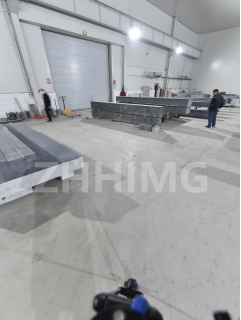Granite machine bases are widely used in the automobile and aerospace industries due to their excellent stability, high precision and durability. However, over time, these machine bases may get damaged due to several reasons: excessive loads, exposure to chemicals, and natural wear and tear. These issues can cause the accuracy of the machine to deviate, leading to errors and subpar outputs. Hence, it is imperative to repair the damaged granite machine base and recalibrate its accuracy to ensure optimal performance.
Step 1: Assess the Damage
The first step in repairing a damaged granite machine base is to assess the extent of the damage. A visual inspection can be conducted to identify any cracks, chips, or other anomalies. It is essential to examine the entire surface carefully, including the corners, edges, and crevices, as these areas are more prone to damage. If the damage is severe, it may require the assistance of a professional technician.
Step 2: Cleaning and Preparation
Before repairing the damaged granite machine base, it is important to clean the surface thoroughly. Use a soft-bristled brush, soap and water, and a degreaser to remove any debris, oil, grime, or contaminants. Allow the surface to dry completely. Then, cover the areas around the damage with masking tape to prevent any spillages or damages.
Step 3: Filling the Cracks
If the damage includes cracks or chips, it is necessary to fill them with a granite epoxy or resin. These fillers are specially designed to match the color and texture of granite and provide a seamless repair. Use a putty knife or trowel to apply the filler evenly. Allow the filler to dry for the recommended time and then sand it smooth using fine-grit sandpaper.
Step 4: Polishing the Surface
Once the repair is complete, it is important to polish the entire surface to restore its shine and luster. Use a granite polishing compound or powder and a buffing pad to polish the surface. Start with a coarse grit and gradually move to finer grits until the surface is smooth and shiny.
Step 5: Recalibrating Accuracy
After repairing the granite machine base, it is necessary to recalibrate its accuracy to ensure optimal performance. This can be done by using precision measuring tools such as a square, level, or dial gauge. These tools can be used to check the flatness, squareness, and levelness of the surface. Adjust the machine settings as necessary to correct any deviations.
In conclusion, repairing a damaged granite machine base requires diligence, attention to detail, and patience. By following the steps outlined above, the appearance of the damaged granite machine base can be restored, and its accuracy can be recalibrated to ensure optimal performance. Remember, regular maintenance and inspection can prevent significant damage to the machine base and increase its longevity.
Post time: Jan-09-2024

